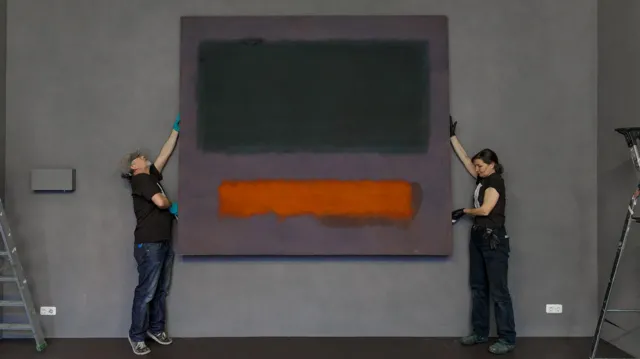A recent incident at the Museum Boijmans Van Beuningen in Rotterdam has sent shockwaves through the art world, as a child inadvertently damaged a highly valuable painting by the American artist Mark Rothko.
The painting, titled Grey, Orange on Maroon, No. 8, is an abstract piece that is estimated to be worth up to €50 million (£42.5 million). According to a spokesperson for the museum, the damage occurred during an “unguarded moment” when the painting was on display in the museum’s Depot, a publicly accessible storage facility adjacent to the main museum. While the damage was described as “superficial,” it involved visible scratches in the unvarnished paint layer on the lower part of the artwork.
The museum, in its statement to the media, confirmed that it was exploring the “next steps” for restoring the painting, but did not go into specifics about the process.
They emphasized that conservation experts had been consulted both within the Netherlands and internationally to assess the situation. The spokesperson reassured the public that the museum was committed to restoring the painting and expected it to be exhibited again in the future.
Despite the incident, the museum maintains that the damage is not catastrophic, but the impact on the viewing experience could still be significant, as Rothko’s paintings are known for their intensity and delicate presentation.
Rothko’s Grey, Orange on Maroon, No. 8 is a quintessential example of his color field paintings, which are characterized by large, flat blocks of color spread across the canvas.
These works are often seen as meditative and are intended to evoke deep emotional responses from the viewer. However, as explained by Sophie McAloone, conservation manager at the Fine Art Restoration Company, such paintings are particularly vulnerable to damage.
“Modern unvarnished paintings like Rothko’s are susceptible to damage due to a combination of their complex materials, lack of a traditional coating layer, and the intensity of the flat color fields,” McAloone explained.
She went on to say that even minor scratches on the surface can significantly impact the viewer’s experience, as these artworks rely heavily on their visual purity to convey their intended effect.
This incident has raised concerns within the broader art community, especially among institutions that are considering the idea of opening up their archives to the public.
Jonny Helm, a marketing manager at Plowden & Smith, an art restoration service, noted that the damage to Rothko’s painting could have implications for other museums that are contemplating more public access to their collections.
“How will this event affect other UK institutions like V&A East and the British Museum, which are considering displaying works that would otherwise remain hidden in archives?” Helm asked, highlighting the delicate balance museums must strike between accessibility and preservation.
Restoring a Rothko painting presents its own set of unique challenges. Helm pointed out that Rothko’s paintings are particularly complex due to his use of a specific mixture of pigments, resins, and glues.
“Rothko’s mixture was quite intricate, and the fact that the painting is unvarnished makes it more susceptible to environmental damage,” Helm explained.
He went on to say that conservators working on this piece will likely be documenting the extent of the damage and researching previous successful restoration methods for similar Rothko works.
“Rothko works seem to have terrible luck – this isn’t the first time one of his pieces has been damaged,” Helm noted, referring to a previous high-profile incident involving the artist’s work.
In 2012, Rothko’s Black on Maroon, a 1958 piece, was deliberately vandalized by Wlodzimierz Umaniec at London’s Tate Modern gallery. Umaniec, who was later convicted and sentenced to two years in prison, had scratched the surface of the painting, causing significant damage.
The cost to repair that work was estimated at £200,000, and it took conservators 18 months to restore the piece. The Tate Modern incident serves as a stark reminder of the vulnerability of Rothko’s works, as his abstract pieces are particularly sensitive to any alterations or damage.
The financial implications of such damage are also significant. Rachel Myrtle, Head of Specie and Fine Arts at Aon, explained that fine art insurance typically covers all risks associated with physical loss or damage, including accidental harm caused by visitors or children.
“When damage occurs, an art gallery’s insurer will appoint a specialist fine art loss adjuster who reviews the damage, examines CCTV footage, and assesses conservation options,” Myrtle said.
The Museum Boijmans Van Beuningen has not commented on whether it plans to seek compensation for the damage or who might be held liable, but the museum has a history of holding visitors accountable for damages.
In 2011, a tourist who accidentally stepped on an artwork was asked to pay for its repairs.
The incident has sparked wider discussions about museum policies on art preservation and the responsibilities of visitors. In 2024, multiple works by Andy Warhol were damaged during an attempted robbery at the MPV art gallery in Oisterwijk, Netherlands, highlighting the risks that artworks face in public spaces.
Additionally, last year, a Dutch town hall admitted to accidentally discarding 46 artworks, including a print by Andy Warhol, during renovations.
These incidents have brought into focus the challenges of maintaining the integrity of valuable artworks while also making them accessible to the public.
Museums around the world have different policies regarding accidental damage caused by children. For instance, in August 2024, a four-year-old boy broke a 3,500-year-old jar at the Hecht Museum in Israel.
Despite the damage, museum worker Lihi Laszlo stated that the museum would not treat the incident “with severity” due to the fact that it was an accident caused by a young child.
Instead, the museum invited the family to return for a tour, showing a more lenient approach to the situation. This contrasts with the approach taken by Museum Boijmans Van Beuningen, which has a history of holding visitors financially responsible for damages.
The case involving the Rothko painting is particularly notable due to its high value and the significant impact that any damage has on the perception of the artwork.
The museum’s decision to display the piece in a public facility, as part of an exhibition featuring “public favorites,” may have inadvertently led to the incident.
The Depot, which is a publicly accessible storage area, allowed visitors to experience the artwork up close, but this accessibility also created the opportunity for the child to accidentally damage the painting.
The museum has been criticized for its handling of the situation, with some questioning whether greater precautions should have been taken to protect such valuable works.
However, the museum maintains that the damage was not due to negligence but rather an unfortunate accident. “It is normal procedure for people to pay if they damage art,” museum spokesperson Sharon Cohen stated during an earlier incident in 2011, in which a visitor stepped on another artwork.
This suggests that the museum may follow a similar course of action in this case, though the outcome remains uncertain.
Despite the controversy surrounding the incident, the museum has stated that it intends to restore the Rothko painting and expects it to be displayed again once the conservation work is complete.
The restoration process will likely take time, as conservators will need to carefully address the damage without compromising the integrity of the piece.
The museum’s spokesperson has expressed confidence that the painting will be restored to its former glory and will continue to be an important part of their collection.
As the art world continues to grapple with the challenges of preserving and displaying valuable works, the incident at the Museum Boijmans Van Beuningen serves as a reminder of the delicate balance that must be struck between accessibility and conservation.
Museums must carefully consider the risks involved in opening their collections to the public, especially when it comes to irreplaceable masterpieces like Rothko’s Grey, Orange on Maroon, No. 8.
The incident also raises questions about the responsibilities of visitors and the measures that institutions can take to prevent similar accidents in the future.



